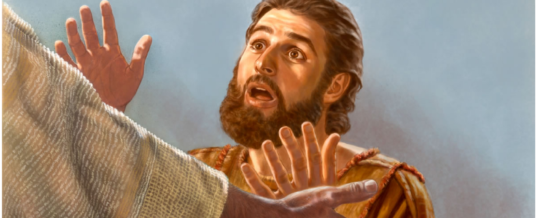
This familiar Easter story, of what we traditionally call the story of Doubting Thomas, is unique to John’s gospel; you don’t find it in the other three gospels. It’s a story of both Jesus’ appearance to the apostles as well as the coming of the Holy Spirit – the Pentecost experience. John does not place Pentecost 50 days after Easter. For him, both the Resurrection and Pentecost happen on Easter Sunday, one before dawn and the other, in the evening.
John begins by telling us that it was evening when Jesus made his appearance. The fact that it was evening tells us that this is a story of people who are still, somewhat, in the dark. Will they become enlightened? Will we become enlightened? Pretend you never heard the story before. It continues: the doors of the house were locked. House, in the scriptures, is code language for “Church.” The Church is locked. If the Church is locked, how are people to have access to Jesus? Do we, as Church, make it hard for people to access Jesus? The group of believers are huddled together for fear of the Jews. The Apostles were immobilized with fear, terrified that they may be next. They were also guilt-ridden for having abandoned Jesus so miserably even though they all swore, at the Last Supper, that they would stand by Jesus.
Fear and guilt are the two things that paralyze us the most. They make us curl up in a ball, with our knees pulled up to our chin. Fear makes us lock doors and prevents us from daring to venture out to engage the world. Into that world of fear, into that house, into that Church, Jesus came through a locked door and stood before the Apostles. Will he lambast them for abandoning him in his time of need? He did call them friends at the Last Supper, some friends they turned out to be! But instead of scolding them or demanding that they make up for their cowardly ways, he breathed peace on them, and he did it twice. It seems like nobody gets it the first time around. On Easter Sunday morning, John the beloved disciple has to look in the tomb twice before he came to believe. Mary Magdalene has to turn twice before she realizes that the gardener is not the gardener but the Risen Lord. Now the Apostles hear the word peace twice. The power of Jesus’ word is such that with one word “Shalom” (peace), he evaporates the Apostles’ fear and dissipated their guilt.
The first time Jesus says, “Peace be with you” it is meant to dispel fear. Remember, Jesus has already told us that perfect love casts out all fear. Once fear is dispelled Jesus breathes on them a second time with the same words, “Peace be with you.” This second breath of peace is not to dispel fear; it is to send them on a mission. Their mission is to freely forgive the sins of any and not to hold people to their sins. Jesus, obvious has not held them to their sins, which were many, so they must freely offer that same forgiveness to others, if they are to be his followers.
There is always a relationship between love and forgiveness. In the world of relationships—and this gospel story is totally about the restoration of relationships—we need lots of love and lots of forgiveness. I love you because you remind me of God’s love. I forgive you for all the times your love falls short of that ideal. And, I hope you do the same for me.
Perhaps the most important and most difficult aspect of love is forgiveness itself. When you really love someone, you will always find a way of digging deeper in order to forgive them when they’ve hurt you. In the very moment of forgiveness, you are a peacemaker. In the very moment of forgiveness, you are breathing out peace just as Jesus did 2000 years ago.
A word about Thomas. Thomas really needed Jesus, and so do we. But in some sense Jesus also needed Thomas, and so do we. Jesus needed someone to point out his wounds. If Jesus didn’t have Thomas, he would have to find someone else, some other way to show us his wounds. You see, even in his resurrected body, Jesus had wounds. Even though suffering and death are in his past, his future contained the wounds he suffered. Even today, Jesus bears the wounds of the Crucifixion. The wounded-yet-resurrected-Christ appears today in the suffering people of the Ukraine, in the lonely, in the homeless, in the depressed, in the separated and divorced, in your body and in mine. Jesus needed a way to let us know that his becoming one of us was not just a short, unpleasant episode that’s over and done with. No! God has a human body even now.
Because of those wounds, Jesus can never forget what he did for us, and neither should we. Jesus can never pretend it never happened. Those wounds are the eternal reminder of how much God loves us. The wounds are the very channels that make available Jesus’ interior life with God.
When we, as Church, become more forgiving, more loving, more serious about restoring relationships, then the mercy of God flows through our own wounds and becomes a source of healing to all those around us. Jesus’ presence is known by the fact that he brings peace in the midst of fear. Wouldn’t it be a wonderful world if our presence was known by the fact that we also bring peace in the midst of fear.
Fr. Phil Mulligan
APR
2022

About the Author: